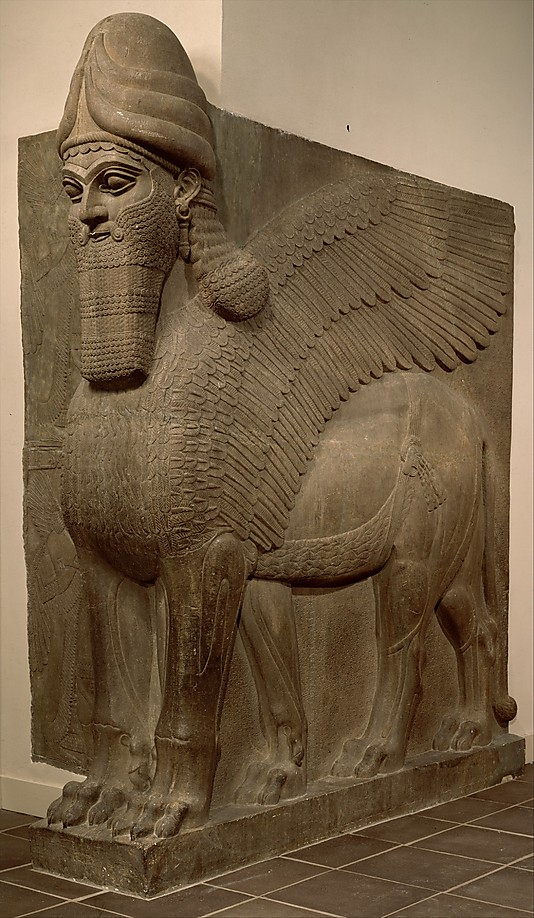
The sculptors of the lamassu located in the East Suite, No. 7 gallery made deliberate and effective aesthetic choices in their depiction of these imaginary creatures. While the faces are somewhat stylized, the execution of the animal portions reveals the artist’s naturalistic skills. Combining stylized and realistic details, these unknown artists were eminently effective in signaling awesome, absolute power.
The lamassu is monumental Neo-Assyrian sculptures of chimerical creatures, formed of capped and bejeweled human heads, lions’ feet, bullock’s haunches1, and huge raptor wings (Unknown). In the 9th century B.C.E., they formed the sides and supports of the palace gate of a new complex in northern Iraq (Nimrud). The two figures are carved from alabaster, also known as gypsum, using Iron Age hand tools.
These massive pieces tower over the viewer, at 10 feet, 3.5 inches, and are visible from afar. The two figures fit snugly into the wall as displayed, reproducing their original setting (Nimrud) in the gateway. (The Metropolitan Museum of Art). The gate itself must have been even more massive, to match the statues’ size.
In terms of the axis, the figures exhibit striking verticality, as the viewer approaches the gate. Their nearly twice man-sized height forces the eye upwards, and the head back, to take in the statues’ heads. When walking through the gate, on the other hand, the figures exhibit an equally striking horizontality. The hindquarters and legs of the creatures are also massive, stretching back for what seems like a length equal to the height. From the side, the sculptor’s secret – an additional (5th) leg – provides an illusion of motion.
The lines of the sculptures are smooth and curvilinear. The sculptures have few protrusions except the nose. Otherwise, these statues seem purpose-designed as practical public art for a high-traffic venue. They would have sustained minimal damage to their low-relief profiles.
However, despite this low profile, they still fill the volume assertively. The statues give a much greater impression of three-dimensionality than they possess. It surprises the viewer, after a distant sighting, to subsequently discover exactly how shallowly they are carved, up close.
Despite their overall size, they are in no way monolithic. They do not lack varied shapes, sizes of elements, and detail. The haunches of the beast are huge, but the leg muscles are indicated by abstracted curving lines typically representing muscular attachments. Over these massive haunches is tied what seems to be a decorative belly band. Such a device could harness the mythic beast to some gargantuan chariot, but the museum identifies this as a belt representing the beings’ power (The Metropolitan Museum of Art). The headdresses, symbolic of divinity, display sweeping upward curves, as do the wings. The beard, hair, feathers, chest hair or fur, and belt are all executed in repetitive, rhythmic patterns with obsessive, painstaking fineness.
The texture seems lovingly crafted with what must have been very delicate chisel work. The ancient practice of painting statuary may have rendered them garishly colorful when they were first guarding the palace. However, now, the warmly neutral stone displays so much differentiation of light and shadow from the harmonious relief carving that it does suffer for lack of color.
The statues were originally probably apotropaic. This means that their powers averted evil from the palace (The Metropolitan Museum of Art).
Their human parts are decidedly human but the animal parts signal immediately that this is not primarily a portrait. Talley Ornan notes an aversion to representing the divine with human forms in 9th century B.C.E. Mesopotamian culture. He suggests that this aversion may even have shaped subsequent Judaic attitudes towards idolatry (Ornan). Perhaps the mixing of animal and human parts allowed the royal builder of the palace at Nimrud, Ashurnasirpal II (r. 883–859 B.C.E.), to feature supernatural guardians without offending local sensibilities.
Archeological studies suggest that these giant figures adorned a newly built palace complex that transformed a small town into a major urban center. The architecture was innovative, although the palace also apparently hearkened back to earlier times through an ancestral cult (Brown). Such references to earlier royalty and the protection of supernatural guardians probably added credibility to Ashurnasirpal II’s role as an expansionist ruler, by connecting him with his notable predecessors, and divinity. The palace interior depicted the king himself, intimately associating with the deities of the Neo-Assyrian pantheon (British Museum). This seems fundamentally similar to displaying a bust of George Washington, and a crucifix, in one’s office.
These figures confirm, in their accurate portrayal of animal parts, the artists’ mastery of realism and naturalism. This reveals that any abstraction or stiffness in execution represents a deliberate, symbolic choice. The statues’ formality reflects a goal of impressing the viewer with the ruler’s divine mandate and intimidating all with his power, rather than any lack of technical skill. The artists achieve their goals superbly. The combination of calm massiveness and harmonious, lavish detail decisively overwhelm the viewer.
Works Cited
British Museum. “Stone relief from the throne room of Ashurnasirpal II.” 2011. British Museum. Web.
Brown, Brian. “Kingship and Ancestral Cult in the Northwest Palace at Nimrud*.” Journal of Ancient Near Eastern Religions 10. 1 (2010): 1-53. 2011. Web.
“Gilgamesh: Tablet 9.” 2011. Academy for Ancient Texts. Ed. Timothy R. Carnahan. Web.
“Nimrud.” 2011. Factum Arte. Ed. Hilarión Eslava. Web.
Ornan, Talley. “Idols and Symbols: Divine Representation in First Millennium Mesopotamian Art and Its Bearing on the Second Commandment.” Tel Aviv: Journal of the Institute of Archaeology of Tel Aviv University 32.1 (2004): 90-121. Web.
Studentreader.com. “assyrian-king-ashurnasirpa.” 2011. Studentreader.com. Web.
The Metropolitan Museum of Art. “Human-headed winged bull and winged lion (lamassu).” 2011. Metropolitan Museum. Web.
Unknown, Neo-Assyrian. Human-headed winged bull and winged lion (lamassu). Metropolitan Museum, New York. Human-headed winged bull and winged lion (lamassu).